.
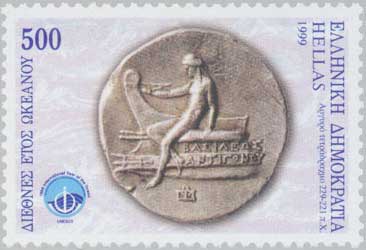
A Coin of Antigonus II Gonatas
The super-galleys of the Hellenistic Age
Today ships are still very important for the military. Giant US airplane carriers are like small cities. Often they are compared with the small triremes showing the advance in technology. Of course the fire power has increased dramatic the last 2300 years. The small 200 crew triremes cannot be compared to the biggest US warships. But if we consider the Hellenistic period we have to consider the larger warships which are not so well known today as maybe the triremes.
In the Hellenistic period the Greeks produced ships of incredible dimensions for that time. In some cases the crew was larger than that of modern US warships (crew size but not the ship dimension) ! It is not clear how such ships could be produced using wood and not steel and special metallic alloys.
περὶ ὧν ὁ αὐτὸς Καλλίξεινoς ἱστoρεῖ ἐν τῷ πρώτῳ περὶ Ἀλεξανδρείας oὑτωσὶ λέγων (FHG III `55): "τὴν τεσσαρακoντήρη ναῦν κατεσκεύασεν ὁ Φιλoπάτωρ τὸ µῆκoς ἔχoυσαν διακoσίων ὀγδoήκoντα πηχῶν, ὀκτὼ δὲ καὶ τριάκoντα ἀπὸ παρόδoυ ἐπὶ πάρoδoν, ὕψος δὲ ἕως ἀκρoστoλίoυ τεσσαράκoντα ὀκτὼ πηχῶν. ἀπὸ δὲ τῶν πρυµνητικῶν ἀφλάστων ἐπὶ τὸ <ὑπὸ> τῇ θαλάσσῃ µέρoς αὐτῆς τρεῖς πρὸς τoῖς πεντήκoντα πήχεις. πηδάλια δ’ εἶχε τέτταρα τριακoνταπήχη, κώπας δὲ θρανιτικὰς ὀκτὼ καὶ τριάκoντα πηχῶν τὰς µεγίστας, αἳ διὰ τὸ µόλυβδoν ἔχειν ἐν τoῖς ἐγχειριδίoις καὶ γεγoνέναι λίαν εἴσω βαρεῖαι κατὰ τὴν ζύγωσιν εὐήρεις ὑπῆρχoν ἐπὶ τῆς χρείας. δίπρῳρoς δ’ ἐγεγόνει καὶ δίπρυµνoς καὶ ἔµβoλα εἶχεν ἐπτά· τoύτων ἓν µὲν ἡγoύµενoν, τὰ δ’ ὑπoστέλλoντα, τινὰ δὲ κατὰ τὰς ἐπωτίδας. ὑπoζώµατα δὲ ἐλάµβανε δώδεκα· ἐξακoσίων δ’ ἦν ἕκαστoν πηχῶν. εὔρυθµoς δ’ ἦν καθ’ ὑπερβoλήν. θαυµαστὸς δ’ ἦν καὶ ὁ ἄλλoς κόσµoς τῆς νεώς· ζῶα µὲν γὰρ εἶχεν oὐκ ἐλάττω δώδεκα πηχῶν κατὰ πρύµναν τε καὶ κατὰ πρῷραν, καὶ πᾶς τόπoς αὐτῆς κηρoγραφίᾳ κατεπεπoίκιλτo, τὸ δ’ ἔγκωπoν ἅπαν µέχρι τῆς τρόπεως κισσίνην φυλλάδα καὶ θύρσoυς εἶχε πέριξ. πoλὺς δ’ ἦν καὶ ὁ τῶν ὅπλων κόσµoς· ἀνεπλήρoυ δὲ τὰ πρoσδεόµενα τῆς νεὼς µέρη. γενoµένης δὲ ἀναπείρας ἐδέξατo ἐρέτας πλείoυς τῶν τετρακισχιλίων, εἰς δὲ τὰς ὑπηρεσίας τετρακoσίoυς· εἰς δὲ τὰ κατάστρωµα ἐπιβάτας τρισχιλίoυς ἀπoδέoντας ἑκατὸν καὶ πεντήκoντα· Athenaeus Deipnosoph. 5.203e-204b (Casson, SSAW p. 103 n. 47).
Athenaeus gives us a detailed description of a very large warship, built by Ptolemy Philopator (c. 244– - 205 BC). It was 130m (420 feet) long, 18m (57 feet) wide, and 22m (72 feet) high to the top of her gunwale. From the top of its sternpost to the water line was 24m (79.5 feet). In comparison the length of the Titanic was 243 m and the largest Oil Tanker around 485 m. It had four steering oars 14m (45 feet) long. It had 40 tiers of oars. The oars on the uppermost tier were 18m (57 feet) long. The oars were counter-balanced with lead to make them easier to handle though its size alone would impress and the broad deck would make a excellent weapons platform.. It had a double bow and a double stern and carried seven rams, of which one was the leader and the others were of gradually reducing size. It had 12 under-girders 275m (900 feet) long. The ship was manned by 400 sailors to handle the rigging and the sails, 4000 rowers and 2850 men in arms for a total of 7250 men. This ship was too large to be of much practical use. Some things of interest about this ship. First, there are no forests worth mentioning in Egypt. All the lumber had to be imported from elsewhere, likely Lebanon. This ship had a crew that was almost twice as large as that of the largest aircraft carrier we have ever built! Athenaeus describes other very large ships and boats of antiquity. One ship had a catapult designed by Archimedes that could hurl a 55 kg (120 pound) stone over 180 m (600 feet).
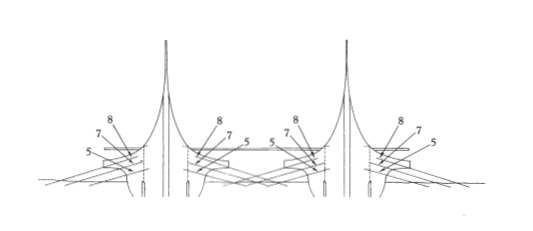
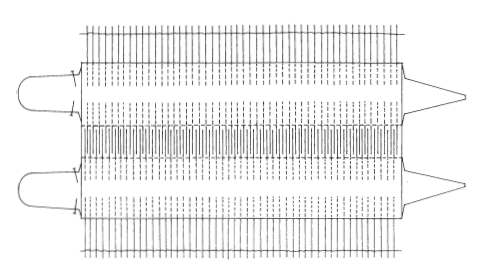
The forty: View from the stern and above
The most convincing argument to date is that of Casson who suggests that the forty of Ptolemy Philopator was a catamaran made up of two twenties fastened together. In this case each of the constituent twenties would have 1000 rowers arranged in three banks of fifty multiple sweeps with 8 men on each thranite oar, 7 on the zygite and 5 on the thalamian. The emphasis returned to boarding and hand to hand fighting, rather than ramming. Because the polyremes were not intended for precision maneuvering the enclosure of all levels of oarsmen below decks was not as important as the ability to carry and employ troops. Thus the Athenian trieres of the 4th century would expect to carry around 14 marines whereas a roman quinqereme of the mid 3rd century would carry 120 marines in addition to the oarsmen. Roman ships were built out of cedar, a durable, red-colored wood. Greek ships in order to be very fast were constructed from lightweight, soft fir trees.
Example of giant ships in the fleet of Ptolemy II:
2 thirties
1 twenty
4 thirteens
14 elevens
2 twelves
30 nines
36 or 37 sevens
5 sixes
17 fives
222-224 quadriremes, triremes, etc.
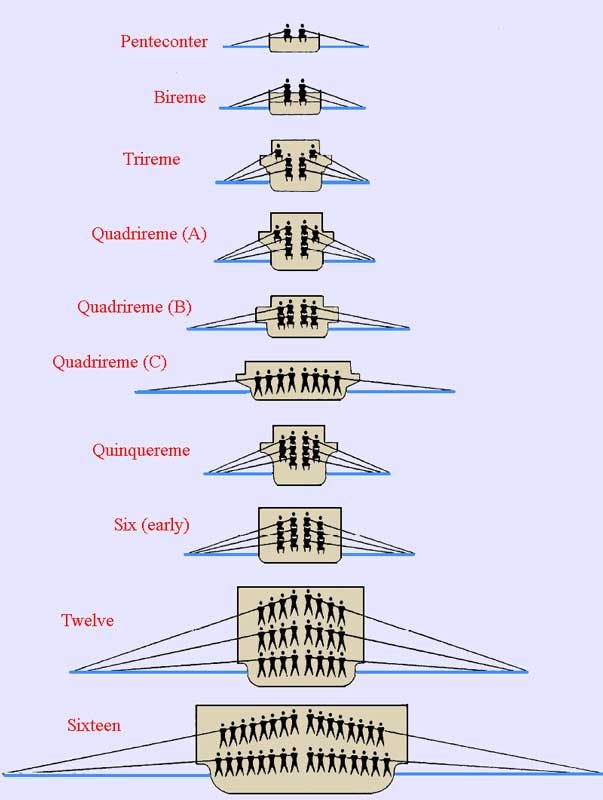
Rowers, Ships, based on Scientific American, April 1981
And he himself was passing evermore from one to another of these places, to give his directions and his assistance to the plans, while all that saw were amazed, not so much at the number, as at the magnitude of the works. Hitherto, there had never been seen a galley with fifteen or sixteen ranges of oars. At a later time, Ptolemy Philopator built one of forty rows, which was two hundred and eighty cubits in length and the height of her to the top of her stern, forty-eight cubits; she had four hundred sailors and four thousand rowers, and afforded room besides for very near three thousand soldiers to fight on her decks. But this, after all, was for show, and not for service, scarcely differing from a fixed edifice ashore, and was not to be moved without extreme toil and peril; whereas these galleys of Demetrius were meant quite as much for fighting as for looking at, were not the less serviceable for their magnificence, and were as wonderful for their speed and general performance as for their size Plutarch Demetrius
Thr thirteen ship of Demetrius Poliorcetes required 1800 rowers. He had also a fifteen and sixteen ship. His ships were produced in Phoenician dockyards (later controled by the Ptolemies). Demetrius was interested in large ships that were able to carry the very large and heavy catapults which were controlled by the so-called catapultists. The sixteen of Demetrius or what was left was discovered by the Romans in a Macedonian harbour around 168 BC when Macedon was finally a part of the Roman Empire
The role of the Giant ships is not clear. There are no images of such ships and no ship such as the elevens to the forty probably was used in the battle. Speculation is that they have been used to demonstrate the military power.
Another famous giant ship is the Leontophoros of Lysimachos, a “eight” probably around 100 meter long ship with 100 men rowing each file and therefore 800 men from each side, and with 1200 fighters on the deck and 2 commanders for the fighters.
The Leontophoros of Lysimachus: Sources for Leontophoros; (PDF File) what are the views of Morrison (Greek and Roman Oared Warships) & Casson (SSAW and Mariner's Mirror 55 (1969) 185-93)?
[Catapults] became a part of every up-to-date fortress and siege train, and gradually they began to be deployed in the more mobile warfare of the battlefield. At sea they may have played a role in the naval arms race that led from the trireme, with its three banks of oars, to huge vessels with as many as 40 banks. Evidently the underlying assumption was that catapult fire could decimate the enemy boarding force while their ship was still too far away to grapple or ram. The larger the ship was, the more catapults it could carry and the more stable its firing platform was. This interpretation, then, sees the catapult superceding hand-to-hand warfare at sea as the cannon did 2000 years later. Eventually the advent of the new battle tactics, of armored ships called cataphracts and of Roman efforts to dominate the entire Mediterranean combined to reduce the size of warships once again. In a political parallel to land warfare, the influence of the citizen-rower was diminished in the process.
Werner Soedel and Vernard Foley, Ancient Catapults
Ships usually were in use only for a few decades. There is a speculation that Caligula the Roman Emperor may have used this ship to transport a 104m long and 20 m diameter large obelisk from Egypt to Rome 250 years after the Giant Ship was build. It may have been placed somewhere as a kind of curiosity and have been used later once for the transport by Caligula. There is a story that maybe supports this. A lighthouse was build near Rome in Ostia and it was build on top of the wreck of a huge ship.
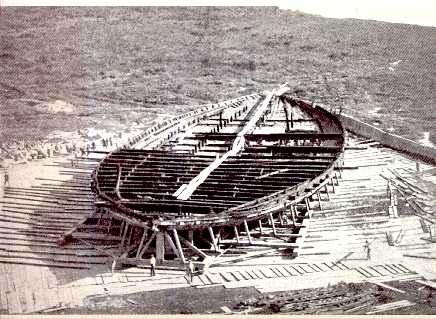
One of two other giant ships (one was a floating palace ) of Caligula anchored on Lake Nemi. The barges were around 70 m (200 ft) long and 18 m (60 ft) wide. Both ships were recovered from the sea in the period 1929-1932 after many attempts before. They were destroyed in 1944 by the German Nazis. (Photo courtesy Diana Nemorensis, some workers in the front are visible)
For more information: See Lake Nemi Roman Ship Reconstruction Project and Caligula's Nemi Ships
Thranites : upper level rower on a trireme
Zygios : middle level oarsman on a trireme
Thalamios : oarsman on lowest level of a trireme.
dekeres, a ten ship
eikoseres, twenty ship
embolos, ram
enneres, nine ship
hendekeres, eleven ship
hepteres, seven ship
okteres, eight ship
penteres, five ship (quinqereme)
TIMELINE
Ptolemy (Ptolemaios) II Philadelphus (Πτολεμαίος ΙΙ Φιλάδελφος) Born 309/8, Died 28-29 January 246 BC
Ptolemy (Ptolemaios) IV Philopator, (Πτολεμαίος ΙV Φιλοπάτωρ ) (May-June) 244 - ( October or November) 204 BC
Cleopatra VII (Philopator Nea Thea) 70/69 -12 August 30 BC (affairs with Caesar: 48-44 BC and Marc Antony: 41-30 BC);
From A Dictionary of Greek and Roman Antiquities (1890) (eds. William Smith, LLD, William Wayte, G. E. Marindin)
The invention of war-ships larger than the trireme, viz. quadrireme and quinquereme, belongs to the epoch which follows that of the Peloponnesian War. In the first half of the 4th cent. B.C. the Athenians possessed a few quadriremes; but the quinquereme, which was destined to be the line-of-battle ship of the succeeding century, had not yet become common. At the siege of Tyre (Curt. ii. 4) Alexander had only one quinquereme as his admiral's ship. Later on we find the Carthaginian fleet consisting mainly of vessels of five banks of oars; and from one of these which fell into their hands, and was used as a model, the Romans constructed those fleets which were engaged at Mylae and Ecnomus and the Aegates Insulae. According to Pliny (vii. § 56), it was Alexander who conceived the idea of constructing still larger vessels, and gave orders for building ships of seven or even ten banks. It remained, however, for his successors to carry out these plans, of whom Demetrius Poliorcetes was the most energetic and successful in matters of naval construction. Demetrius himself superintended the building of vessels of fifteen and sixteen banks (Plut. Dens. 43), and this passion for huge ships seems to have continued among the Macedonians (cf. Liv. xxxiii. 16, Regiam unam inhabilis prope magnitudinis quam sedecim versus remorum agebant ). Ptolemy Philadelphus had fourteen ships of eleven, two of twelve, four of thirteen, one of twenty, and two of thirty banks of oars. To surpass these latter, Ptolemy Philopater constructed the Great Eastern of ancient days, the famous Tesseraconteres, a triumph of naval architecture in point of construction, but useless for practical purposes, and in reality only the splendid toy of a despotic king. Her dimensions, as given in Athen. v. p. 203, are as follows:--Length, 420 ft. breadth (within parodi), 57 ft.; height, forward 72 ft., aft 79 ft. She had four rudders, each 45 ft. long, and her upper tier of oars (thranitikai) were 57 ft., weighted with lead inboard. She was diprôros and diprumnos; had seven beaks, of which one was longer than the rest; also beaks projecting from the catheads (kata tas epôtidas). She had twelve hupozômata, each 900 ft. long; that is, sufficient to gird her from stem to stern. Her proportions were graceful, and her ornamentation elaborate. Figures of animals, 18 ft. in length, adorned both stem and stern, and every available surface was covered with painting, the whole of the rowing space from the keel upwards being decorated with ivy wreaths and thyrsi. The rowing complement was over 4,000; the marines numbered 2,850; there were 400 seamen (?) for the service of the ship; and below decks a vast multitude of people.
Such, in brief, are the details preserved concerning this remarkable vessel, which however, probably after her trial trip, was left for show in the dock specially constructed for her by a Phoenician engineer.
As regards dimensions, she was about the same as H.M.S. Warrior (420 ft. [multi] 58 ft.), an ironclad of a type now becoming obsolete. It is not possible to be certain as regards the meaning of diprôros and diprumnos, but Graser's view seems plausible, that she was, in construction, anticipatory of the class of twin vessels (such as the Castalia and Calais-Douvres), which have been tried of late with varying success. It would seem however, from the mention of the seven beaks, that the double prow was prolonged into one, at all events above the water-line, and, in all probability, the double stern likewise, so that the Acrostolia and Aphlasta would be as in other vessels. The four rudder paddles would thus probably have been carried two on each side, as often seen in Egyptian vessels, though Graser seems to suppose one on each side of the two sterns. The disposition of the rowers in the Tesseraconteres has been a matter of much controversy.
It is interesting to find that Graser in his detailed description of the Tesseraconteres has adopted for her as for all the larger rates above quinquereme a reduced scale, allowing only 7 instead of 8 square ft. per man for rowing space, and the vertical distance of the banks from 2 ft. to 1 foot. Probably this is also nearer the true measurement in the smaller rates from quinquereme downwards. Allowing 20 ft. for draught, the Tesseraconteres gave a height of 44 ft. on either side for the insertion of 40 banks of oars. The curvature of the vessel fore and aft, and the consequent contraction of the rowing space, would necessarily diminish the number of men in each tier from the highest to the lowest. Graser, by an ingenious calculation, brings the total number of oarsmen to 4054 (Athen.: oligôi pleious tôn tetraschiliôn). For the disposition of these (allowing 7 ft. interscalmium) there was for the topmost bank on each side a longitudinal space of 367 ft., in which were seated on either side the 53 thranites (the topmost men of 53 complexus, diagonal lines, of oarsmen), and for the lowest, or thalamite bank, a longitudinal space of 345 ft. Of the 53 complexus, 40 were complete, giving a sum of 1600 on each side. In the remaining 13, incomplete complexus, 427 men found their places on either side (3200 + 854 = 4054). The principle of the zugôsis must have been similar to that of the trireme [see NAVIS], benches (zuga) being fitted between the vessel's side and the diaphragmata, though in the case of the Tesseraconteres these were probably divided by decks at certain intervals. The upper tiers of oars, when fastened to the skalmos or thowl pin, were almost at equilibrium between the outboard and inboard portions, so that the movement of the whole would not be difficult. The oar-ports of the thalamites must have been dangerously close to the water. Graser places them at 2 1/4 ft. above the water-line less than those of the trireme, which were not under 3 ft. And perhaps this is the reason of the terms in which Plutarch speaks of her (Dem. 43): alla thean monên ekeinê paresche, kai mikron hoson diapherousa tôn monimôn oikodomêmatôn phanênai pros epideixin, ou chreian, episphalôs kai dusergôs ekinêthê. [E. W.]
Giant Triremes
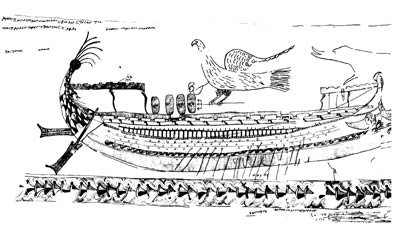
The ISIS Trireme from the Nymphaion fresco. assumed to be 60 m long (width and height 15 m)
The Isis Ship of Ptolemy II Philadephus (PDF)
Morrison, GROW, 207-214 (Nymphaion Fresco) , W.M. Murray, "Observations on the "Isis Scraffito" at Nymphaion," 1-14 , N. Grac, "Ein neu entdecktes Fresko aus hellenistischer Zeit in Nymphaion bei Kertsch," in Skythika, Bayerische Akademie der Wissenschaften, Phil-Hist. Klasse, Abhandlungen, Neue Folge,. Heft 98, (1987) 85-95.
References
Athenaeus, The Deipnosophists, Book 5, (Loeb Classical Library No. 208, Harvard University Press, 1987)
The age of supergalleys (PDF File) Selection from Casson, L. Ships and Seafaring in Ancient Times 1994
Casson, "The Super Galleys of the Hellenistic Age," Mariner's Mirror 55 (1969) 185-93 (PDF)
Casson : The Age of the Supergalleys (PDF)
Lionel Casson, The Ancient Mariners: Seafarers and Sea fighters of the Mediterranean in Ancient Times (2nd ed.), Princeton University Press, 1991
Lionel Casson, Ships and Seamanship in the Ancient World , Princeton, N.J., Princeton University Press, 1971. ISBN: 0691035369
Deborah N. Carlson, Caligula's Floating Palaces Volume 55 Number 3, May/June 2002
LINKS
La plus grande galere de l’antiquité?Dimensions et forme de la coque (Abstract French)
Compare Size of Ships
Another Comparison including the Leontophoros of Lysimachos and the 187 meter long HMS Belfast ( Europe's last big gun armoured warship of World War II The HMS Belfast )
The Ptolemaic Dynasty
The Future: The Freedom Ship
German Reports
Die Kriegsschiffahrt zur Zeit der Griechen
Basch L. , The tessarakontores of Ptolemy IV Philopator. Mariner's Mirror, 55: 381-382, 1969
HISTORY AND ARCHAEOLOGY OF THE SHIP - General Bibliographies
| Ancient Greece
Science, Technology , Medicine , Warfare, , Biographies , Life , Cities/Places/Maps , Arts , Literature , Philosophy ,Olympics, Mythology , History , Images Medieval Greece / Byzantine Empire Science, Technology, Arts, , Warfare , Literature, Biographies, Icons, History Modern Greece Cities, Islands, Regions, Fauna/Flora ,Biographies , History , Warfare, Science/Technology, Literature, Music , Arts , Film/Actors , Sport , Fashion --- |

